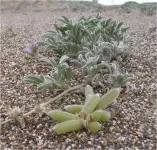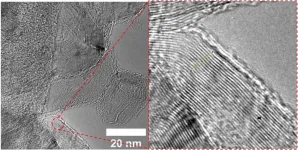Common medications contain animal byproducts, study finds
No FDA regulations in place to alert patients when medication is derived from animals
2021-03-29
(Press-News.org) More physicians and pharmacists are advocating for patients to be made aware of animal byproducts contained in common medications, according to new research in the Journal of Osteopathic Medicine. Common medications, including widely used blood thinners and hormones, are often derived from animal byproducts and prescribed without consulting the patient about their beliefs.
"Patients deserve to know what their medications are made of, yet this information is rarely shared," said Sara Reed, student doctor at Lincoln Memorial University (LMU) DeBusk College of Osteopathic Medicine and an author of the paper. "Putting the patient first means communicating with them about the medicine recommended for their care, and in some cases, prescribing an alternative option."
Common Animal-derived Medications
Heparinoids are a class of medication primarily derived from pigs. These drugs are routinely used as a blood thinner to prevent blood clots and are given in many settings, including following surgery, a heart attack, or to prevent the further development of clots.
Also common are conjugated estrogens, which may be used to treat moderate to severe hot flashes and other symptoms of menopause. They are equine-derived hormones.
"Generally, patients who are prescribed various hormone treatments may want to consult their physician regarding the contents," said Mary Beth Babos, PharmD, professor of pharmacology at LMU, and lead author of the paper. "For example, there are no completely animal-free oral thyroid hormones on the market."
Existing Guidelines
While the U.S. does not have formal recommendations, other nations have published guidelines to address pharmaceuticals of animal origin. The United Kingdom's first guidelines were published in 2004 and Australia's guidelines were published in 2007 and updated again in 2019. However, guidelines from the FDA remain unavailable.
Cultural Competency
Because some patients adhere to religious doctrine that recommends avoiding certain animal byproducts, the study authors reviewed prior medical research to identify the stated positions of leadership of the major world religions. According to their findings, many religions discourage the use of products derived from animals when not required to save human life.
Jewish and Muslim leaders agree that the use of products derived from pigs--normally prohibited by both religions--are acceptable only when needed to protect human life.
The Hindu Council of Australia does not consider bovine products, including medications derived from cows, acceptable.
Sikh leaders and leaders of the Hindu Vaishnav sect object to the use of medication or surgical dressing derived from animal sources, which is waived in emergency situations or in routine treatment where no alternative exists.
Many Buddhists of the Theravada sect and Christians of the Seventh Day Adventist sect who practice vegetarianism as part of their faith may individually reject animal-derived medical products.
Leaders of the Jehovah's Witness sect emphasized that adherents to this faith would reject blood-derived products.
"In the absence of governmental guidance, we hope this research will help physicians and prescribers start the conversation with patients about whether they accept animal-derived products," said Reed. "Ultimately, it is the patient who should determine if a medication is appropriate for their lifestyle."
INFORMATION:
About the Journal of Osteopathic Medicine
The Journal of Osteopathic Medicine, founded in 1901 and known for 119 years as The Journal of the American Osteopathic Association, is the premier scholarly, peer-reviewed publication of the osteopathic medical profession. JOM conducts peer review of academic research manuscripts from a wide variety of medical specialties, covering the full spectrum of clinical settings in which osteopathic physicians practice. All submissions are vetted by a distinguished group of Section Editors led by Editor-in-Chief Ross Zafonte, DO, and supported by a full Editorial Board.
ELSE PRESS RELEASES FROM THIS DATE:
2021-03-29
Climate change is altering the world we share with all living things. But it's surprisingly difficult to single out climate change as an extinction threat for any one particular species protected under the Endangered Species Act.
To date, the U.S. Fish and Wildlife Service has only formally considered impacts from climate change in listing actions for four animal species and one alpine tree.
But the effects of climate change extend to temperate climates as well. A new analysis of population data published in the journal Ecosphere shows that climate change represents a specific extinction threat for an endangered coastal lupine plant.
Biologists including Eleanor Pardini at Washington University in St. Louis have tracked all of the known stands ...
2021-03-29
HOUSTON - (March 29, 2021) - This could be where the rubber truly hits the road.
Rice University scientists have optimized a process to convert waste from rubber tires into graphene that can, in turn, be used to strengthen concrete.
The environmental benefits of adding graphene to concrete are clear, chemist James Tour said.
"Concrete is the most-produced material in the world, and simply making it produces as much as 9% of the world's carbon dioxide emissions," Tour said. "If we can use less concrete in our roads, buildings and bridges, we can eliminate some of the emissions at the very start."
Recycled tire waste is already used as a component of Portland cement, but graphene has been proven to strengthen cementitious materials, ...
2021-03-29
SUVA, Fiji (March 29, 2021) - A new study published in the journal Environmental Science and Policy addresses the impacts of COVID-19 and Cyclone Harold on Indo-Fijians engaged in small scale fisheries.
The paper says that countries, including Fiji, need to address ethical and social justice considerations and the politics of recovery efforts by putting vulnerable and marginalized groups front and center in the aftermath of pandemics and natural disasters.
What countries cannot afford is for economic recovery efforts to put additional burdens and risk on those invested in the SSF sector, and cause further widening of inequities, and increase ...
2021-03-29
A new study out of the University of Chicago and the University of Illinois Urbana-Champaign in humans, chimpanzees, rhesus macaques and baboons has found key differences in early gene expression in response to pathogen exposure, highlighting the importance of choosing the right animal model for the right questions. The study was published on March 26 in END ...
2021-03-29
A national survey of parents revealed that most parents who used ride-share services did so with their children, but only half of the respondents reported that children who were 8 years or younger traveled in the recommended child car seats or booster seats when in ride-share vehicles. Among parents of children in this age group, over 40 percent used only a seat belt for their child, while 10 percent allowed their child to travel on a lap or unrestrained. Overall, parents reported lower rates of child car seat use in ride-share compared with how their child usually travels. Findings were published in the journal Academic Pediatrics.
"Our results are concerning, as ...
2021-03-29
Barcelona researchers at the Hospital Clínic-IDIBAPS Research Institute, the University of Barcelona and the SOLTI academic cancer research group have shown that the molecular classification of breast cancer, which divides it into four subtypes (Luminal A, Luminal B, HER2-enriched and Basal-like) is useful for predicting the benefits of treatment in patients with advanced hormone-sensitive breast cancer. This is the largest study to have shown the value of the biomarker, and the first to do so in the context of a CDK4/6 inhibitor like ribociclib.
The study, published in the Journal of Clinical Oncology of the American Society of Clinical Oncology (ASCO), was coordinated by Professor Aleix Prat, head of the Medical Oncology ...
2021-03-29
CHAPEL HILL, NC - A team led by scientists at the UNC School of Medicine discovered an important vulnerability of the AIDS-causing retrovirus HIV, and has shown in preclinical experiments that a widely used diabetes drug, metformin, seems able to exploit this vulnerability.
The scientists, whose study is published in Nature Immunology, found that HIV, when it infects immune cells called CD4 T cells, helps fuel its own replication by boosting a key process in the cells' production of chemical energy. They also found that the diabetes drug metformin inhibits the same process and thereby suppresses HIV replication in these cells, in both cell-culture and mouse experiments.
"These findings suggest that metformin and other drugs that reduce T cell metabolism ...
2021-03-29
PHOENIX, Ariz. -- March 29, 2021 -- A review of more than 20 studies by researchers at Arizona State University and the Translational Genomics Research Institute (TGen), an affiliate of City of Hope, suggests that nonalcoholic fatty-liver disease (NAFLD) is a growing dietary problem for children across the globe.
"The prevalence of fatty-liver disease is escalating not only in adults, but also in children," said Johanna DiStefano, Ph.D., a Professor and head of TGen's Diabetes and Fibrotic Disease Unit, and the review's senior author. "Like type 2 diabetes, NAFLD used to be considered a disease that developed only in adulthood, ...
2021-03-29
Younger trees take up and release less water than mature trees 10 years or older, researchers from North Carolina State University found in a new study that tracked how water moves through wetland pine forests near the North Carolina coast.
Their findings, published in Agricultural and Forest Meteorology, suggest managers should time timber harvests to leave older trees alongside new growth to mitigate runoff.
"The water balance, especially in coastal sites, is very important," said the study's lead author Maricar Aguilos, postdoctoral research associate in forestry and environmental resources at NC State. "We have so much water there. We wanted to understand how land-use changes impact water use and drainage in the forests, ...
2021-03-29
Five years ago, scientists created a single-celled synthetic organism that, with only 473 genes, was the simplest living cell ever known. However, this bacteria-like organism behaved strangely when growing and dividing, producing cells with wildly different shapes and sizes.
Now, scientists have identified seven genes that can be added to tame the cells' unruly nature, causing them to neatly divide into uniform orbs. This achievement, a collaboration between the J. Craig Venter Institute (JCVI), the National Institute of Standards and Technology (NIST) and the Massachusetts Institute of Technology (MIT) Center for Bits and Atoms, was described in the journal Cell.
Identifying these genes is an important step toward engineering synthetic cells that do useful things. Such ...
LAST 30 PRESS RELEASES:
[Press-News.org] Common medications contain animal byproducts, study finds
No FDA regulations in place to alert patients when medication is derived from animals



